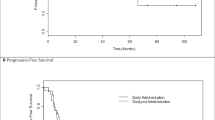Abstract
The Japan Cord Blood Bank Network (JCBBN) reports the treatment of 22 children with acute myeloid leukemia (AML) who received umbilical cord blood transplantation from unrelated donors (CBT) as their second hematopoietic stem cell transplantation (HSCT). Provided by the JCBBN, between February 1997 and September 2006, 22 patients had CBT as a second HSCT. In the initial HSCT, eight received autologous, seven received CBT, and the remaining had allogenic BMT. At the time of CBT as a second HSCT, seven were in the second complete remission (CR2), two in the third CR (CR3), the remaining were not in remission. Reduced intensity conditioning (RIC) conducted for 10 cases and myeloablative conditioning (MAC) for 12 cases. The overall survival rate was 31.3%, 5 years after CBT. Second complete remission at second transplantation was favorable prognosis (58.3 ± 18.6%, compared with 17.1 ± 10.8% for the non-CR group. Mortality after CBT as a second HSCT accounted for 15 cases, 8 from treatment-related mortality. In conclusion, CBT combined with RIC as second HSCT may be useful against a recurrence of AML in children after the initial HSCT.


Similar content being viewed by others
References
Eapen M, Giralt SA, Horowitz MM, Klein JP, Wagner JE, Zhang M-J, et al. Second transplant for acute and chronic leukemia relapsing after first HLA-identical sibling transplant. Bone Marrow Transplant. 2004;34:721–7.
Meshinchi S, Leisenring WM, Carpenter PA, Woolfrey AE, Sievers EL, et al. Survival after second hematopoietic stem cell transplantation for recurrent pediatric acute myeloid leukemia. Biol Blood Marrow Transplant. 2003;9:706–13.
Radich JP, Sanders JE, Buckner CD, et al. Second allogeneic marrow transplantation for patients with recurrent leukemia after initial transplant with total-body irradiation-containing regimens. J Clin Oncol. 1993;11:304–13.
Isoyama K, Ohnuma K, Ikuta K, Toyoda Y, Nakajima F, Yamada K, et al. Unrelated cord blood transplantation for second hemopoietic stem cell transplantation. Pediatr Int. 2003;45:268–74.
Satwani P, Cooper N, Rao K, Veys P, Amrolia P. Reduced intensity conditioning and allogeneic stem cell transplantation in childhood malignant and nonmalignant diseases. Bone Marrow Transplant. 2008;41:173–82.
Glucksberg H, Storb R, Fefer A, Buckner CD, Neiman PE, Clift RA, et al. Clinical manifestations of graft-versus-host disease in human recipients of marrow from HL-A-matched sibling donors. Transplantation. 1974;18:295–304.
Storb R, Prentice RL, Sullivan KM, Shulman HM, Deeg HJ, Doney KC, et al. Predictive factors in chronic graft-versus-host disease in patients with aplastic anemia treated by marrow transplantation from HLA-identical siblings. Ann Intern Med. 1983;98:461–6.
Mehta J, Powles R, Treleaven J, Horton C, Meller S, Pinkerton CR, et al. Outcome of acute leukemia relapsing after bone marrow transplantation: utility of second transplants and adoptive immunotherapy. Bone Marrow Transplant. 1997;19:709–19.
Champlin R, Khouri I, Shimoni A, Gajewski J, Kornblau S, Molldrem J, et al. Hernessing graft-versus-malignancy; non-myeloablative preparative regimens for allogeneic haematopoietic transplantation, an evolving strategy for adoptive immunotherapy. Br J Haematol. 2000;111:18–29.
Gomez-Almaguer D, Ruiz-Arguelles GJ, Tarin-Arzaga Ldel C, Gonzalez-Llano O, Jaime-Perez JC, Lopez-Martinez B, et al. Reduced-intensity stem cell transplantation in children and adolescents: the Mexican experience. Biol Blood Marrow Transplant. 2003;9:157–61.
Roman E, Cooney E, Harrison L, Militano O, Wolownik K, Hawks R, et al. Preliminary results of the safety of immunotherapy with gemtuzumab ozogamicin following reduced intensity allogeneic stem cell transplant in children with CD33 + acute myeloid leukemia. Clin Cancer Res. 2005;11(19 Part 2):7164s–70s.
Nagler A, Or R, Naparstek E, Varadi G, Slavin S. Second allogeneic stem cell transplantation using nonmyeloablative conditioning for patients who relapsed or developed secondary malignancies following autologous transplantation. Exp Hematol. 2000;28:1096–104.
Rao K, Amrolia PJ, Jones A, Cale CM, Naik P, King D, et al. Improved survival after unrelated donor bone marrow transplantation in children with primary immunodeficiency using a reduced-intensity conditioning regimen. Blood. 2005;105:879–85.
Bosi A, Laszlo D, Labopin M, Reffeirs J, Michallet M, Gluckman E, et al. for the Acute Leukemia Working Party of the European Blood and Marrow Transplant Group. Second allogeneic bone marrow transplantation in acute leukemia: results of a survey by the European Cooperative Group for blood and marrow transplantation. J Clin Oncol. 2001;19:3675–84.
Arellano ML, Langston A, Winton E, Flowers CR, Waller EK. Treatment of relapsed acute leukemia after allogeneic transplantation: a single center experience. Biol Blood Marrow Transplant. 2007;13:116–23.
Acknowledgments
This work was supported (in part) by a Research Grant for Tissue Engineering (H17-014), and a Research Grant for Allergic Disease and Immunology (H20-015) from the Japanese Ministry of Health, Labor, and Welfare.
Author information
Authors and Affiliations
Corresponding author
Appendix
Appendix
1.1 Transplant centers
Transplant centers that performed CBT by the JCBBN coordination and produced follow-up reports are: Division of Pediatric Oncology, National Cancer Center Hospital, Tokyo; Division of Hematology/Oncology, Kanagawa Children’s Medical Center, Yokohama; Department of Pediatrics, Ibaraki Children’s Hospital, Mito; Division of pediatrics, Osaka City General Hospital, Osaka; Department of Pediatrics, Saitama Medical university, Iruma; Division of Hematology/Oncology, Saitama Children’s Medical Center, Iwatsuki; Department of Hematology/Oncology, Osaka Medical Center and Research Institute for Maternal and Child Health, Osaka; Department of Pediatrics, Hamanomachi Hospital, Fukuoka; Department of Pediatrics, Hirosaki University School of Medicine, Hirosaki; Division of Pediatric Hematology/Oncology, Nagoya Red Cross First Hospital, Nagoya; Department of Pediatrics and Developmental Biology, Tokyo Medical and Dental University, Tokyo; Department of Pediatrics, Tottori University Faculty of Medicine, Yonago; Department of Pediatrics, Faculty of Medicine, University of the Ryukyus, Nishihara; Department of Pediatric Hematology and Oncology, Tohoku University School of Medicine, Sendai; Hamamatsu University School of Medicine, Hamamatsu; Department of Pediatrics, University of Occupational and Environmental Health, Kitakyushu; Department of Hematology-Oncology, Tokyo Metropolitan Kiyose Children’s Hospital, Kiyose; Department of Pediatrics, University of Tokyo, Tokyo; Department of Pediatrics, Osaka City University Graduate school of Medicine.
About this article
Cite this article
Oda, M., Isoyama, K., Ito, E. et al. Survival after cord blood transplantation from unrelated donor as a second hematopoietic stem cell transplantation for recurrent pediatric acute myeloid leukemia. Int J Hematol 89, 374–382 (2009). https://doi.org/10.1007/s12185-009-0266-9
Received:
Revised:
Accepted:
Published:
Issue Date:
DOI: https://doi.org/10.1007/s12185-009-0266-9




